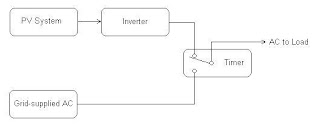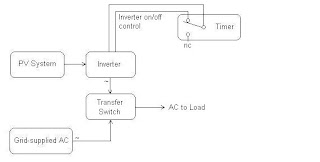My current electric bill is hard to understand, but from a recent one this is what I’ve been able to determine:
I am charged 0.072 per kwh of electricity of electricity I use.
With taxes, customer charge, distribution charge, and other miscellaneous charges and credits, I am actually paying 0.1016 per kwh.
Based on program information from the utility’s website, I’ll be paying as little as 0.015 per kwh when demand is low, or as much as 0.15 per kwh when demand is high. In addition to the rate information available to me over the Internet, I’ll be alerted when rates are expected to exceed 0.13 per kwh.
A new electric meter was installed on December 3rd, allowing my electricity use to be monitored by time-of-day.
To get the most from this program I’ll run as many daytime loads as possible off of my solar photovoltaic (PV) system. To the extent that my small system can keep up, I’ll run my refrigerator and chest freezer off of it. At night, when rates are low, I’ll run them off of grid-supplied power. Fortunately, the PV system operates most efficiently during the day because energy goes straight to the load, instead of being stored in and retrieved from batteries. As I add solar panels to my existing array, I’ll add electrical items to the daytime load when utility rates are highest.
Perhaps the easiest way to switch between the grid and solar is by way of a simple timer and relay as illustrated below:

 The transfer switch can be wired so that it selects the inverter when AC is present, and switches to grid-supplied power when necessary. The timer can be programmed to switch the inverter on during the day, and off at night.
The transfer switch can be wired so that it selects the inverter when AC is present, and switches to grid-supplied power when necessary. The timer can be programmed to switch the inverter on during the day, and off at night.With nightly electricity rates below 0.035 per kwh, I’ll have to reevaluate my Plug-In-Electric-Vehicle (PHEV) recharging strategy. It no longer seems practical to purchase extra solar panels for this. I’ll buy extra panels for the daytime loads instead.
I might also benefit from this plan by using the grid to charge batteries. I'll charge batteries at night when rates are low, and use the stored energy to power household loads during the day when rates are high. I suspect that the losses associated with storing and retrieving energy will be more than offset by the low nighttime electric rates.
As I gain experience, I suspect that I’ll discover other ways to get the most from this plan. I welcome suggestions and comments from others.
For more information about the plan I’ve signed up for, click here: http://www.powersmartpricing.org/
John








4 comments:
Kewl!
I am voluntarily load-shedding at peak times (4pm to 8pm UK winter) at home and in one data centre, though it would be great to actually have a scheme like yours where somebody notices!
Rgds
Damon
Now that you've had it in place for a couple months, I was wondering what you thought about the Power Smart Pricing? How much have you been saving? Do you ever worry about not saving anything? Please feel free to email, if you like. Thanks.
I've only received one power smart pricing bill so far, but it looks like I've saved a considerable amount. I'll post details once I've been in the program for awhile and I've had a chance to look more closely. I've learned that I can go to the Ameren website and view my use on an hour-by-hour basis. That's a lot of data to analyze.
I've been cutting use early in the evening when rates tend to be high and that seems to be helping. I'm also beginning to shift loads to my PV system during those times.
Since my wife and I are both trying to shift loads to off-peak hours, I don't think I'll have to worry about not saving anything. Load shifting, and utilizing solar at the right time, is becoming a habit.
sj
I've been signed up for Power Smart Pricing for about 3 months now myself. I love it, it's saved me money, and it's easy to get into the habit of looking at the energy prices before running the dishwasher.
Post a Comment